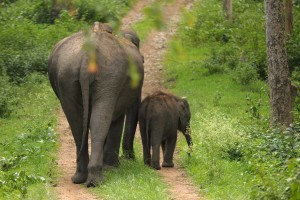
 By Nava Thakuria*
By Nava Thakuria*
Guwahati: The shocking death of 18 wild Asiatic elephants due to electrocution by lightening within seconds can be justified with only an absurd argument, stated All Assam Engineer’s Association (AAEA) demanding a high-level scientific investigation into the Nagaon incident that took place on the night of 12 May. The forum of engineering graduates termed it as a matter of serious concern (caveat) for the wildlife and entire human race, if such a massive thunderbolt had stricken the planet on that fateful night.
As the State government in Dispur, precisely the forest minister and the preliminary findings of a probe committee, claimed that it might be a thunderbolt that killed all 18 bulky animals within seconds, the debate needs to focus on the essential volume of energy to hit all the jumbos at a time. Even if, it is assumed that the animals were close to each other during the incident, they needed more than 36 square-meter area to accommodate themselves (means the area of impact), pointed out the AAEA statement.
Engineering science narrates that a lightning strike, created by the electrical discharges due to imbalances caused between the Earth and storm clouds (or sometimes within the clouds), can produce 40 Kilovault to 120 kV and 5 Kiloampere to 200 kA. Hence in an average a lightning bolt (from cloud to ground) may generate around 1,000,000,000 Watt (around one billion volts of electricity) and it can heat the surrounding air to 53000º Fahrenheit (5 times hotter than the Sun’s surface).
When the cloud-to-ground lightning hit an animal, it creates sudden disturbances to the internal electric signals of a living being, which is necessary for functioning of organs like heart, lungs and the nervous system. Normally the affected animal faces a cardiac arrest, brain Injuries, spinal cord damages or even severe burns and subsequently it succumbs to wounds. Worldwide around 2,000 people are killed every year by the incidents of lightning, where of course many survive with long lasting injuries.
“Hammering all the elephants within seconds demands a huge volume of energy that could have generated a massive thunder and light. So the news of such a thunderbolt in the Nagaon locality could have preceded the actual happening,” claimed AAEA president Er Kailash Sarma, secretary Er Inamul Hye, adding that there was no visible major burns on the site and none in the locality admitted that they heard such a massive sound of thundering in the last few days.
*Senior journalist and working president of AAEA





